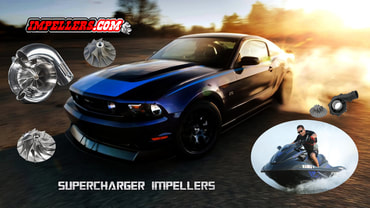Turbo Charger Impeller
Turbo impellers available for performance or replacement. The new turbo impeller will give up to 20hp increase.
How Turbo chargers works
A turbocharger impeller, also known as a turbine wheel or compressor wheel, is a critical component of a turbocharger system. A turbocharger is a forced induction system that compresses the air entering the engine, allowing for more fuel to be burned and increasing the power output of the engine.
The turbocharger impeller is mounted on a shaft that is connected to both the compressor and turbine sides of the turbocharger. The turbine side is connected to the exhaust system of the engine, and as the hot exhaust gases pass over the turbine, it spins the shaft and impeller. The compressor side of the turbocharger is connected to the engine's intake system, and as the impeller spins, it compresses the air entering the engine, increasing the density of the air and allowing for more fuel to be burned.
The shape and size of the impeller blades are critical to the performance of the turbocharger. The blades are designed to be aerodynamically efficient, allowing the impeller to spin at high speeds without creating too much turbulence or resistance. The blades are also shaped to increase the velocity of the air as it passes through the compressor, maximizing the amount of air that can be compressed and delivered to the engine.
The turbocharger impeller operates in a high-temperature, high-pressure environment, so it's typically made from materials that can withstand these conditions, such as stainless steel or titanium. The impeller is also balanced to reduce vibration and ensure smooth operation at high speeds.
In summary, a turbocharger impeller is a crucial component of a turbocharger system that compresses the air entering the engine, increasing the power output of the engine. The impeller is designed to be aerodynamically efficient and made from materials that can withstand high temperatures and pressures.
The turbocharger impeller is mounted on a shaft that is connected to both the compressor and turbine sides of the turbocharger. The turbine side is connected to the exhaust system of the engine, and as the hot exhaust gases pass over the turbine, it spins the shaft and impeller. The compressor side of the turbocharger is connected to the engine's intake system, and as the impeller spins, it compresses the air entering the engine, increasing the density of the air and allowing for more fuel to be burned.
The shape and size of the impeller blades are critical to the performance of the turbocharger. The blades are designed to be aerodynamically efficient, allowing the impeller to spin at high speeds without creating too much turbulence or resistance. The blades are also shaped to increase the velocity of the air as it passes through the compressor, maximizing the amount of air that can be compressed and delivered to the engine.
The turbocharger impeller operates in a high-temperature, high-pressure environment, so it's typically made from materials that can withstand these conditions, such as stainless steel or titanium. The impeller is also balanced to reduce vibration and ensure smooth operation at high speeds.
In summary, a turbocharger impeller is a crucial component of a turbocharger system that compresses the air entering the engine, increasing the power output of the engine. The impeller is designed to be aerodynamically efficient and made from materials that can withstand high temperatures and pressures.



